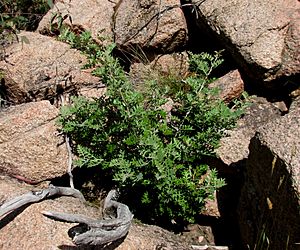Omeo grevillea facts for kids
Quick facts for kids Omeo grevillea |
|
|---|---|
 |
|
| Grevillea willisii, Bundara River, Alpine National Park, Victoria | |
| Scientific classification | |
| Genus: |
Grevillea
|
| Species: |
willisii
|
The Grevillea willisii, also known as Omeo Grevillea or Rock Grevillea, is a type of shrub that grows only in the eastern highlands of Victoria, Australia. It's a special plant because it's found naturally in only one part of the world!
This plant can grow quite tall, usually between 2 and 4.5 metres high. It often has a cool grey-green look. Its leaves are a bit prickly and have deep cuts, almost like fingers. Both the bottom of the leaves and the stems are covered in thick, light-coloured hairs, making them feel soft.
You can see its flowers from September to January, which is early spring to mid-summer in Australia. These flowers grow in spikes at the ends of branches. They have creamy white parts called perianths and pale yellow styles, which are parts of the flower that help with reproduction. When the flowers turn into fruits, they have interesting dark streaks.
Contents
Discovering and Naming the Plant
Scientists officially described Grevillea willisii for the first time in 1975. This description was published in a science journal called Muelleria. The plant was named after James Hamlyn Willis, who was a very important botanist (a plant scientist) in Victoria. It's a way to honor his work!
Different Types of Grevillea willisii
There are two main types of Grevillea willisii that scientists have identified:
- One type has shorter leaves. This kind is found north and east of a town called Omeo.
- The other type has longer leaves and grows south of Corryong. What's cool about this type is that its flowers have a nice scent!
A plant that was once thought to be a part of G. willisii (called G. willisii subsp. pachylostyla) was later recognized as its own separate species in 1994. It's now known as Grevillea pachylostyla. This shows how scientists sometimes learn more about plants and change how they classify them.
Where Grevillea willisii Grows
You can find G. willisii growing in rocky areas, especially on granite rocks and near streams. It likes to be close to the Mitta Mitta River and in places like Nariel and Wheelers Creek. These specific locations are important for its survival.
Protecting the Plant
Grevillea willisii is considered a "Rare" plant in Victoria. This means there aren't many of them left in the wild. The Department of Sustainability and Environment in Victoria keeps a special list of rare or threatened plants, and G. willisii is on it. This helps people know which plants need extra protection to make sure they don't disappear.
Growing Grevillea willisii in Gardens
If you want to attract birds to your garden, Grevillea willisii can be a great choice! It provides safe places for birds to build nests and offers them a source of nectar, which is a sweet liquid birds love to drink.
Sometimes, these plants can have small problems. Tiny insects called leaf miners might affect the leaves, or the leaves might turn yellow, a condition called chlorosis. But don't worry, these are usually minor issues.
You can grow new Grevillea willisii plants from semi-mature cuttings. This means taking a piece of a healthy plant and helping it grow roots. It can take up to five months for the cuttings to grow roots, so you need to be patient!
Hybrid Grevillea Plants
Scientists and plant lovers sometimes cross different types of plants to create new ones. These are called hybrids.
- Grevillea 'Poorinda Anticipation' is a hybrid plant that was created by crossing G. willisii with another plant called G. longifolia.
- Another strong hybrid is 'Poorinda Royal Mantle'. It was created by a plant expert named Leo Hodge in Victoria and registered in 1978. People think it's a mix between G. willisii and G. laurifolia. These hybrids show how G. willisii can be used to create beautiful and strong new garden plants!

